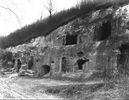

|
|
|
|
|
|
|
|
|---|
Under this a story follows as there have been thousands. Many of them have been forgotten. It was sent to me from Australia by somebody whose father was in the valkenburg resistance, too. It reminds us of the innumerable people who have shown commitment for the many small but also big daily underground activities. Sometimes something goes wrong. Particularly on these occasions they risked their lifes.
March 25th, 1932. The limestone caves Bronsdalgroeve and the Vlaberg on Geulweg, Meerssen-Geulhem. Towards the end of the war, in this subterranean part of the limestone quarry a German workshop for the revision of aircraft engines was set up here. In the vicinity of this underground part of the limestone quarries was the provisional hostel for people to hide (“divers inn”).
The youngest sister (Carla) of Pierre Schunck told that once their father Peter, the owner of the quarry and the cave, should guide a group of Germans through the enterprise. He knew about the divers inn. When the Germans wanted to visit the cave too, he struck with a stick a few pieces of limestone from the ceiling and said, “We can not go on here, because of the risk of collapse!”
Suddenly the Germans wanted to get out and never came back again.
Source of the picture: Historisch Centrum Limburg (HCL)
The following story needs a little explanation.
- It was sent to me from Australia by a son of Coen Grotaers, see below, who was involved in the resistance in the limestone quarry too.
- There were two limestone quarries in Geulhem at the Geul near the Meerssenerbroek at that time. One of them was property of Peter Schunck, the father of Pierre Schunck. One part of it was a far branched cave system. There the diver’s inn was installed. The other quarry belonged to the Wim Curfs mentioned below.
- The following story is probably about „Ausweise“ (ID cards) which had been looted at the raid on the distribution office in Valkenburg. Let’s hope that after that accident somebody went once again with new cards to Kaldenkirchen.
- The methane gas of which he writes, was no wood gas, although only the german army (Wehrmacht) had gasoline. The wood carburettors to produce it were not harmless. A small factory was attached on the tail or on the roof of the vehicle. There the wood was heated up. Wood gas and tar were among others the results. So one didn’t tank but one put some new logs on. Usually one loaded the system, when it was cold. But during a long journey, when the system was hot (because otherwise it wouldn’t work) it could catch fire. But this is not what happened here, writes the son of Coen Grotaers. His father drove a truck powered by methane gas from the factory. Probably a product from the coke oven at the pit.
- This mail shows too, that there were contacts with German resistance groups.
- For a better understanding of this story, you should read also the part of the interviews with Pierre schunck, in which he tells about the resistance activities in the Duikherberg.
Hi, to whom it may concern.
My name is Victor Grotaers and I live in Australia, north-east of Melbourne.
My Father (Coen Grotaers) was part of the group in the Dölkesberrig (Duikherberg) in Geulhem and also worked for Peter Schunck in the mergel-groeve where he operated the steam powered drag-line crane from about 1943 till about 1946, which was used to mine the mergel and load it onto trucks. (This dragline had a 2 cubic meter bucket and I know it was steam powered because I used to go with him sometimes and would have to sit on one of those large brick-shaped compressed coals that went into the boiler!)
I have seen some accounts of the resistance movement on the Internet and recognised a lot of names from their accounts of what our parents had done during their activities in the movement.
Both my parents were involved in the resistance movement. My mother used to also cook meals for the „onderduikers“ and hide these in a false bottom in my pram. Myself and my younger brother Peter were the decoys! (I was born in 1942) (We used to live in the first house up the top of the Bronsdalweg in Berg en Terbijt)
On one occasion my Father was driving a truck (I don’t know if it belonged to Schunck or Wim Curfs). He had to go to Kaldenkirchen in Germany with 172 false "Ausweisen" to get people out of that concentration camp. The truck ran on Methane gas. After filling the truck in Sittard something went wrong and the truck severely caught fire, Dad was badly burned but survived. This happened on the 15th March 1944 the day before my brother Peter was born.
My Father died here in Australia in 1979.
I would love to know if there is any records and photo’s in the archives that corroborate our parent’s involvement in the resistance movement.
Many Thanks, Victor Grotaers
Remark: Do you have any information on the Grotaers family? Please get in touch with me, I then will pass it on.
09/08/2019
Hi Arnold,
Reading through that article pertaining to the Duikerberg. It talks about an escape route in case the Germans entered the Duikerberg. I remember another line of defense that was in place that dad often talked about. There was a tin with a supply of little sponges which had been wiped on the backsides of dogs "on heat". Whenever any Germans came around to search the caves with their tracker dogs, someone would scattered these small sponges around which then rendered their dogs useless.
Victor
.jpg/120px-Valkenburg_aan_de_Geul-Provinciaal_Verzetsmonument_op_de_Cauberg_(12).jpg)
